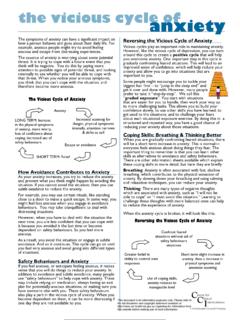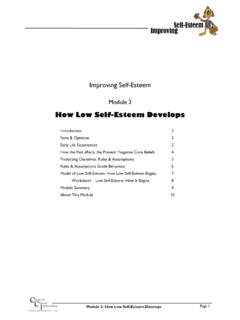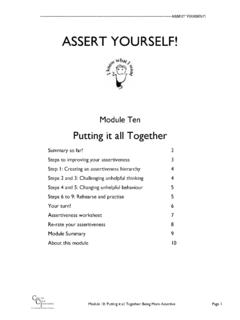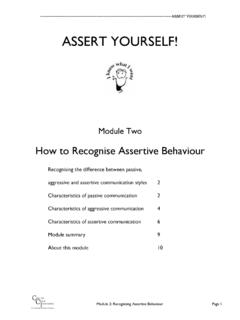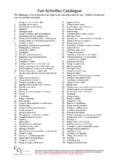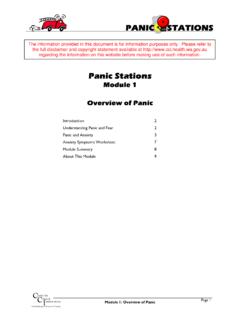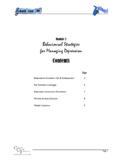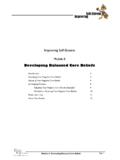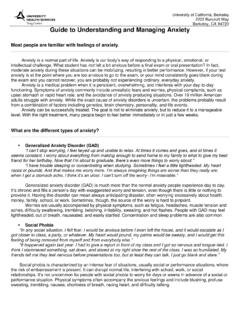Transcription of what is anxiety? - CCI
1 Flee from the situation, or stand and fight. The main purpose of the fight/flight response is to protect the individual. It is therefore important to remember that the experience of anxiety is not in itself, harmful. When a person s fight/flight response is activated, three major systems are affected. These are the physical, cognitive and behavioural systems. Physical System When we believe that we are in danger, our whole physical system undergoes some major, temporary changes designed to enhance our ability to either run away, or stand and be ready to fight. Physically, as soon as danger is perceived, the brain sends a message to our autonomic nervous system.
2 Our autonomic nervous system has two sections: the sympathetic branch and the parasympathetic branch. These two sections control the physical changes that occur in the fight/flight response. The sympathetic branch is the part that activates the various areas of the body to be ready for action. When the sympathetic branch is activated, it includes all areas of the body, and therefore, the person experiences physical changes from head to toe. To get things moving, the sympathetic nervous system releases two chemicals from the adrenal glands on the kidneys. These chemicals are called adrenalin and noradrenalin and are basically messengers that serve to maintain the physical changes for a sufficient amount of time.
3 So what are these physical changes that the sympathetic mechanism produces when you are anxious? 1. An increase in heart rate and strength of beat One physical change that is quite noticeable to the person experiencing the fight/flight response, is an increase in heart rate and the strength of heartbeat. An increase in heart rate enables blood to be pumped around the body faster, so that oxygen gets delivered more promptly to the various tissues of the body and waste products can be efficiently eliminated. 2. A redistribution of blood from areas that aren t as vital to those that are There is also a change in blood flow - away from places where it is not needed (such as skin, fingers and toes) towards the places it is likely to be needed (large organs and muscles).
4 This is very useful because if we were attacked and cut in some way we would be less likely to bleed to death, as the blood will be with the vital organs. This physical change results in the skin looking pale and feeling cold, and also in the experience of cold, numb and tingling fingers and toes. 3. An increase in the rate and depth of breathing As well as changes to heart rate, there are also changes to the speed and depth of breathing. This is very important, as it provides the tissues with the extra amount of oxygen required to prepare for action. The feelings produced by this increase in breathing can include breathlessness, choking or smothering feelings, tightness and pain in the chest, and sighing and yawning.
5 One of the main anxiety ? Many people experiencing the symptoms of anxiety can begin to wonder if there is something really wrong with them. One typical fear is that they might be going crazy. Unfortunately, the reactions and comments from other people such as, just get yourself together are not very helpful. Although you might feel alone in your struggle against anxious moods, the reality is that many people experience these moods either from time to time, or on a more regular basis. In fact, it is estimated that 1 in every 5 experience significantly anxious mood at some time in their life. anxiety can effect any kind of person at any stage of their life, whether they are an introvert or an extrovert, socially active or shy, youthful or elderly, male or female, wealthy or poor.
6 Whatever your distinction, you can become anxious. That means that any person you know is also fair game. So remember, you are not alone. Understanding anxiety Feeling afraid is very much a part of the experience of being human. It occurs in response to realistically anticipated danger and therefore is a survival instinct. For example, if a ferocious animal confronted us it is likely that we would respond with fear. This response is important because it initiates a whole series of physical and behavioural changes that ultimately serve to protect us. In this example, when confronted by an animal, the feeling of fear would probably lead us to either run for our lives or become sufficiently pumped up to physically defend ourselves.
7 As you can see from this example, the experience of fear is part of a process of survival. The experience of anxiety is very similar to the experience of fear - the main difference is that anxiety occurs in the absence of real danger. That is, the individual may think that they are in danger but the reality is that they are not. To illustrate this, think of the anxiety one may feel when walking down a poorly lit alley. The individual may feel anxious because they perceive some potential danger. This may not mean that there is any real danger in walking down this particular alley, but what causes the experience of anxiety is that the person believes that they are in danger.
8 Therefore, the experience of anxiety and fear are basically the same except that in the case of anxiety , there may not be any actual danger - the person just thinks there is. Fight/Flight Response It is important to fully understand the way our bodies react to threat or danger, whether real or imagined. When a person is in danger, or believes that they are in danger a number of changes occur. This response has been named the fight/flight response. As previously explained, when confronted with danger we will typically Centre forClinicalInterventions Psychotherapy Research Trainingwhat is Pg 1 of 2 This document is for informa on purposes only.
9 Please refer to the full disclaimer and copyright statement available at h regarding the infor ma on from this website before making use of such informa on. of counteracting the sympathetic branch. As a result, the heart rate begins to slow, breathing rate slows, the body s temperature begins to lower and the muscles begin to relax. Part of the process of restoration is that the systems do not return to normal straight away. Some arousal continues and this is for a very good reason. In primitive times, if a wild animal confronted us it would be foolish to relax and be off guard as soon as the animal began to back off. The chances of danger continuing in such a case causes the body to remain prepared for the need to once again face danger.
10 Therefore, some residual effects of the fight/flight response remain for some time and only gradually taper off. This can leave the individual feeling keyed up for some time afterwards. This helps to understand why it is that people can feel anxious for ongoing periods of time when no obvious stressor is present. what Causes anxiety ? The combination of factors which result in an individual developing an anxiety disorder differ from person to person. However, there are some major factors that have been identified, which may be common to sufferers. These factors can be effectively divided into biological and psychological causes. Biological Factors A genetic factor has been linked to the development of anxiety disorders.
